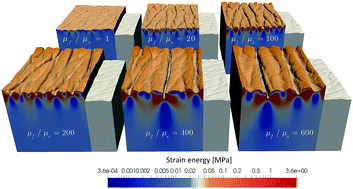当前位置:
X-MOL 学术
›
Soft Matter
›
论文详情
Our official English website, www.x-mol.net, welcomes your feedback! (Note: you will need to create a separate account there.)
On skin microrelief and the emergence of expression micro-wrinkles
Soft Matter ( IF 3.4 ) Pub Date : 2018-01-02 00:00:00 , DOI: 10.1039/c7sm01969f G. Limbert 1, 2, 3, 4, 5 , E. Kuhl 6, 7, 8, 9, 10
Soft Matter ( IF 3.4 ) Pub Date : 2018-01-02 00:00:00 , DOI: 10.1039/c7sm01969f G. Limbert 1, 2, 3, 4, 5 , E. Kuhl 6, 7, 8, 9, 10
Affiliation

|
Over the course of a life time, as a result of adaptive mechanobiological processes (e.g. ageing), or the action of external physical factors such as mechanical loading, the human skin is subjected to, and hosts complex biophysical processes. These phenomena typically operate through a complex interplay, that, ultimately, is responsible for the evolutive geometrical characteristics of the skin surface. Wrinkles are a manifestation of these effects. Although numerous theoretical models of wrinkles arising in multi-layered structures have been proposed, they typically apply to idealised geometries. In the case of skin, which can be viewed as a geometrically complex multi-layer assembly, it is pertinent to question whether the natural skin microrelief could play a significant role in conditioning the characteristics of compression-induced micro-wrinkles by acting as an array of geometrical imperfections. Here, we explore this question through the development of an anatomically-based finite strain parametric finite element model of the skin, represented as a stratum corneum layer on top of a thicker and softer substrate. Our study suggests that skin microrelief could be the dominant factor conditioning micro-wrinkle characteristics for moderate elastic modulus ratios between the two layers. Beyond stiffness ratios of 100, other factors tend to overwrite the effects of skin microrelief. Such stiffness ratio fluctuations can be induced by changes in relative humidity or particular skin conditions and can therefore have important implications for skin tribology.
中文翻译:

关于皮肤微浮雕和微皱纹表达的出现
在适应生命的过程中,由于适应性的机械生物学过程(例如老化)或外部物理因素(例如机械负荷)的作用,人类皮肤会遭受并承载复杂的生物物理过程。这些现象通常通过复杂的相互作用起作用,最终导致皮肤表面的进化几何特征。皱纹是这些影响的体现。尽管已经提出了许多在多层结构中产生的皱纹的理论模型,但它们通常适用于理想的几何形状。就皮肤而言,它可以看作是几何复杂的多层组件,因此有必要质疑天然皮肤微浮雕是否可以通过充当阵列来在调节压缩性微皱纹的特征方面发挥重要作用。几何缺陷。这里,较厚和较软的基材顶部的角质层。我们的研究表明,对于两层之间的适度弹性模量比,皮肤微起伏可能是调节微皱纹的主要因素。刚度比超过100时,其他因素往往会覆盖皮肤微浮雕的效果。这种硬度比的波动可能是由相对湿度或特定皮肤状况的变化引起的,因此对皮肤摩擦学具有重要意义。
更新日期:2018-01-02
中文翻译:

关于皮肤微浮雕和微皱纹表达的出现
在适应生命的过程中,由于适应性的机械生物学过程(例如老化)或外部物理因素(例如机械负荷)的作用,人类皮肤会遭受并承载复杂的生物物理过程。这些现象通常通过复杂的相互作用起作用,最终导致皮肤表面的进化几何特征。皱纹是这些影响的体现。尽管已经提出了许多在多层结构中产生的皱纹的理论模型,但它们通常适用于理想的几何形状。就皮肤而言,它可以看作是几何复杂的多层组件,因此有必要质疑天然皮肤微浮雕是否可以通过充当阵列来在调节压缩性微皱纹的特征方面发挥重要作用。几何缺陷。这里,较厚和较软的基材顶部的角质层。我们的研究表明,对于两层之间的适度弹性模量比,皮肤微起伏可能是调节微皱纹的主要因素。刚度比超过100时,其他因素往往会覆盖皮肤微浮雕的效果。这种硬度比的波动可能是由相对湿度或特定皮肤状况的变化引起的,因此对皮肤摩擦学具有重要意义。



























 京公网安备 11010802027423号
京公网安备 11010802027423号